The Blueprint 3 is Jay-Z’s 11th studio album and was released on the 8th September 2009. This album is one of Jay-Z’s more commercial albums featuring chart topper’s such as “Run This Town”,”Young Forever” and “Empire State Of Mind” which was Jay’Zs first number 1 on the Billboard 100.The album was clearly created to be commercially appealing and I believe that should be taken into consideration as I carry out my research on Young Guru.
Today I carried out some initial research research on Young Guru and I found an interview with him and Sound on Sound magazine. In one segment of the interview Young Guru starts talks about his method of recording Jay Z
“My signal chain is normally a Neumann 87 or 67 going into an Avalon 737. I love the way the Avalon preamp sounds with his voice. It’s a perfect match.”
The Neumann u87/u67 are both very high end large diaphragm condenser microphones and are famous for giving an extremely neutral vocal recording ,the Avalon 737 is a top of the line channel strip that adds warmth,definition and presence to a recording. Jay-Z has a very distinguishable voice so it is clear why such a neutral microphone would be put through a channel strip that can add even more to his unique voice. For my project I will be doing all of my vocal recording using a Neumann 87,this will allow me to capture a neutral sound and will not stop the creative process in production . However I can try to imitate these choices Young Guru made using the equipment that is available to me.
With regards to the Avalon 737, the multi track studio has a Chameleon 7720 compressor that I will be running all my vocal tracks though.The Chameleon 7720 is the closest thing to the Avalon I can get my hands on and it will allow me to imitate the Avalon’s audio processing capabilities.
This post relates to Learning Outcome 5
Full Interview is available at https://www.soundonsound.com/people/secrets-mix-engineers-young-guru

